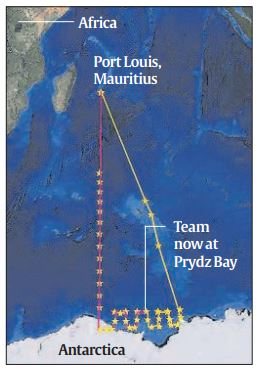11th Expedition of an Indian Mission to the Southern Ocean | 15 Feb 2020
Why in News
The South African oceanographic research vessel SA Agulhas has started its journey for the 11th expedition of an Indian mission to the Southern Ocean, or Antarctic Ocean from Port Louis (Mauritius).
- Currently, the research vessel was located at Prydz Bay, in the coastal waters of “Bharati”, India’s third station in Antarctica.
NOTE: The research vessel SA Agulhas is named after Agulhas warm ocean current that runs south along the east coast of southern Africa.
India’s Antarctic Missions
- India officially acceded to the Antarctic Treaty System on 1st August 1983. On 12 September 1983, India became the fifteenth Consultative Member of the Antarctic Treaty.
- India is expanding its infrastructure development in Antarctica. The newest base commissioned in 2015 is Bharati.
- India is rebuilding its station, Maitri, to make it bigger and last for at least 30 more years.
- Dakshin Gangotri, the first Indian base established in 1984, has weakened and become just a supply base.
Key Points
- Objectives:
- The National Centre for Polar and Ocean Research (NCOPR) stated that the mission intends to quantify changes in the oceanic remote area and the impact of these changes on large-scale weather phenomenon, like the Indian monsoon.
- It also aims to understand the influence of the Southern Ocean across ecosystem and atmospheric changes and how it affects the tropical climate and weather conditions.
- The Expedition consists of six core projects:
- Hydrodynamics and biogeochemistry of the Indian Ocean sector of the Southern Ocean at different depths. It will help to understand the formation of Antarctic bottom water.
- Observations of movement of trace gases (halogens and dimethyl sulphur) from the ocean to the atmosphere which will help to improve parameterisations that are used in global models.
- Study of organisms namely, coccolithophores (existed in the oceans for several million years).The study of their concentrations in sediments will create a picture of past climate.
- Investigate atmospheric aerosols and their optical and radiative properties. Its continuous measurements will quantify the impact on Earth’s climate.
- Study the Southern Ocean’s impact on Indian monsoons.
- Dynamics of the food web in the Southern Ocean which will help to implement sustainable fishing.
Significance of the Expedition
- Cyclic Movement of Carbon Dioxide:
- The carbon dioxide (CO2 ) is emitted in tropical regions and through atmospheric circulation, it reaches to the Antarctic and polar regions.
- Due to the low temperature in these regions, CO2 is absorbed and converted into dissolved inorganic carbon or organic carbon.
- Further, through water masses and circulation it is coming back to tropical regions. Since it is warmer in these areas, it re-enters the atmosphere,
- The expedition will help to plot the quantity and time period for such cyclic movement of CO2.
- The Southern Ocean- A Transport Agent :
- The expedition will help to study the Southern Ocean as it connects all the major oceans around the world. Thus the conveyor belt that circulates heat around the world is connected through the Southern Ocean and can have a large impact on climate change due to anthropogenic forces.
National Centre for Polar and Ocean Research
- National Centre for Polar and Ocean Research (NCPOR) was established as an autonomous research and development institution of the Ministry of Earth Sciences in 1998.
- It is located in Goa.
- It is responsible for the country’s research activities in the Polar and Southern Ocean realms.
- It is the nodal agency for planning, promotion, coordination and execution of the entire gamut of polar and southern ocean scientific research in the country as well as for the associated logistics activities.
- Its major responsibilities include:
- Management and upkeep of the Indian Antarctic Research Bases “Maitri” and “Bharati”, and the Indian Arctic base “Himadri”.
- Management of the Ministry’s research vessel ORV Sagar Kanya as well as the other research vessels chartered by the Ministry.
